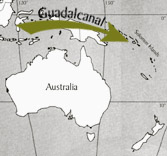Guadalcanal
The Guadalcanal Campaign was the United States’ first major offensive engagement in the Pacific War.
On Dec. 7, 1941, a surprise attack on Pearl Harbor left the U.S. Navy forces in the
Pacific in disarray. Over the next few  months, U.S. forces reacted to Japanese
aggression in the Pacific. By June 1942, the Japanese forces were establishing their third
major base in the Solomon Islands - at Guadalcanal. The Allies feared the airfield at
Guadalcanal would allow the Japanese to isolate Australia.
months, U.S. forces reacted to Japanese
aggression in the Pacific. By June 1942, the Japanese forces were establishing their third
major base in the Solomon Islands - at Guadalcanal. The Allies feared the airfield at
Guadalcanal would allow the Japanese to isolate Australia.
On Aug. 7, U.S. Marines captured the airbase on Guadalcanal, naming it Henderson Field and beginning a desperate battle to defend the base from the Japanese forces that fled into the jungle and the determined air attacks. Once the runway was completed, the "Cactus Air Force" took to the skies from Henderson Field to provide air cover for the island. Capt. Joe Foss, whose unit took over the fight on Oct. 9, became the lengthy battle’s leading ace, and the second one to earn the Medal of Honor.
By February 1943, the Japanese had fully retreated from the area.
Foss flew into the annuls of history in a Grumman F4F "Wildcat" fighter. These single-engine workhorses of the early Pacific air war had a range of about 250 miles and a top speed around 315 mph.
The Wildcats contributed heavily to the Allied victory at Guadalcanal. The Japanese lost approximately 650 aircraft and many airmen between August and November 1942 - most to F4Fs.
The pilots got the drop on the more-maneuverable Japanese Zeroes by flying the rugged Wildcat with more skill and at higher speeds. The F4F pilots used their .50-caliber wing guns to decimate the Japanese.
By 1943, the Wildcat was being replaced by more powerful fighters, notably, the F6F "Hellcat," but continued to play an important support role in escort duties and against U-boats in the Atlantic.